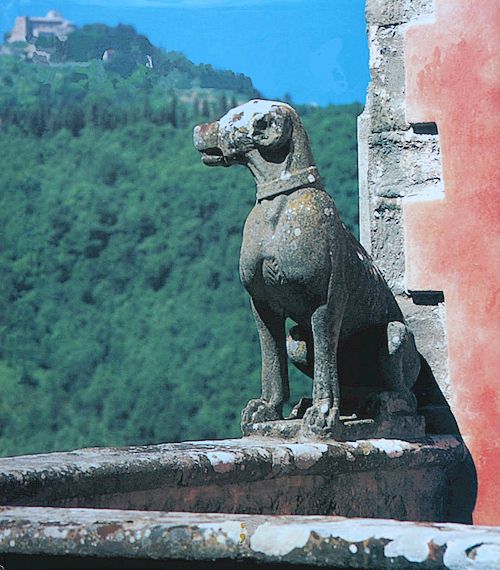Every visitor to Tuscany experiences the power of fine architecture and paintings on the grand scale, but let's not forget the endless enchanting details of
Tuscan vernacular art that reflect the love of fine workmanship that has characterised Tuscany since at least the end of the Dark Age. Among the most prolific and accessible anonymous works of
art in Tuscany are those in cast iron, carved wood and sculpted stone. And the age of the digital camera makes these miniature masterpieces all the more accessible since many of them are in locations often too high to be seen other than by means of a zoom lens. Not all of course - door knockers and door wood carvings are right there to be observed close up by those with a sharp eye for detail.
 |
| Tuscan art deco door-knocker |
|
 |
| Exquisite door wood-carving |
|
Vernacular stone carving is often less visible since so much of it is the quirky and humorous production of the mediaeval artisans who turned out decorated capitals and pilastres by the thousands. When visiting any of the numerous
romanesque churches that dot the Tuscany countryside, look high up both inside and outside and the chances are you will see some fascinating and completely unique stone carving, possibly from the hand of a workman a thousand years gone.
 |
| Stone carving at Villa Viganamaggio |
|
 |
| Capital at the Abbey of Santa Mustiola |
|
As you will no doubt notice, Tuscany is a very "stony" region and stone or stone-faced buildings outnumber those made entirely of brick, with wooden buildings being almost non-existent. It turns out that workable stone is quite common so, not surprisingly, stone carving embellishes buildings magnificent and humble throughout the area. Workable wood is for the most part imported from elsewhere but skilled wood carving has been a part of Tuscan art since the Renaissance and earlier when the Gothic art of fine woodcarving was introduced from Flanders.
 |
| Capital at the Abbey of Sant' Antimo |
|
 |
| Stonework at Borgo di Vagli hamlet |
|
Cast iron decorative elements became extremely popular in the late Victorian and art deco periods and continue to be right up to the present day. Wrought iron work is also extremely common in Tuscany and is most commonly visible in the form of iron grills over windows. Wrought iron bedsteads, candelabra and chandeliers are typical of "Tuscan country style". The streets of Sienna are particularly well-endowed with wrought and cast iron decorations, including lamp supports and flag holders.
 |
| Cast iron shop sign in Sienna |
All of these details contribute to the charm of Tuscan cities, towns and villages. They repay attention!
More about what to see in Tuscany.
More about Borgo di Vagli.
My recommended vacation rentals in Tuscany.
 |
Don't forget to visit Elena Spolaor's
Travel Guide!
Up-to-date news on what to see and where to stay in Chianti and all of Tuscany & Umbria.
Chianti Travel Guide
|
|
Author: Anna Maria Baldini






